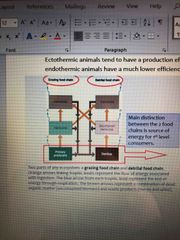![]()
![]()
![]()
Use LEFT and RIGHT arrow keys to navigate between flashcards;
Use UP and DOWN arrow keys to flip the card;
H to show hint;
A reads text to speech;
10 Cards in this Set
- Front
- Back
|
Give a definition of a primary producer |
Autotrophs/ use the sun’s energy to photosynthesize and survive, producing oxygen as waste (self-nourishers) |
|
|
Give ways that energy is lost through trophic levels |
Lost through heat, used in respiration, waste. |
|
|
Give several trends seen often in the higher levels of food chains |
Higher trophic levels tend to support: fewer species, smaller populations, have a larger body size, lower reproductive rates, food with higher calorific value and a greater assimilation efficiency |
|
|
Give the two ways seconday production can be calculated |
Production = growth + natality Production = net change in biomass + losses by mortality |
|
|
How is growth efficiency calculated? |
Growth efficiency = energy fixed in tissues / energy assimilated |
|
|
How is consumption efficiency calculated? |
Intake at trophic level n / net productivity at trophic level n-1 |
|
|
What are the equations for assimilation, production and growth efficiency? |
Assimilation: energy assimilation / energy consumed Production: energy fixed in tissues / energy consumed Growth: energy fixed in tissues / energy assimilated |
|
|
What is the difference between the grazing and detrital food chain? |

Grazing: primary producers, herbivores, carnivores. Detrital: detritus, decomposer herbivores, carnivores. |
|
|
What is the equation for decomposition? |
Decomposition = sum of component losses attributable to catabolism (K), communition (C) and leaching (L). D = KCL |
|
|
What are the 5 stages of decay? |
AoooL - freshly fallen, undecomposed needles AooF - dark brown, intact recogniseable, colonised fungi F3 - greyish, fragmented, recogniseable needles AoH - humus-like, amorphous mass of animal faeces/microbes A1 - intimate mixture of humus and mineral soil |

